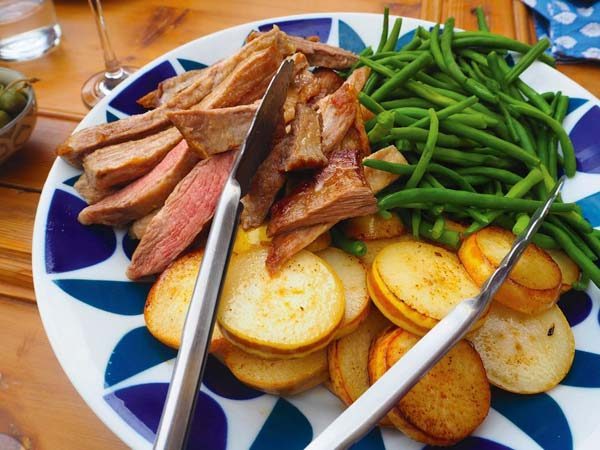A day spent immersed in the hospitality of “Barcelona food sherpa” Sarah Stothart unveils an insight into a food culture that’s all about product – and the tradition, flavour and quality therein.
Sarah says she rarely adds anything more than a little salt to the dishes she cooks for her guests. “That way,” she explains, “people are getting a real taste of Spain, from the ingredients, and not simply my take on them.”
Too much cheffy food, thinks Sarah, masks the real credit due to the growers and producers. And Spain is a dab hand at growing fruit and vegetables, accounting for around 40 per cent of Europe’s production, she points out. Of course, it helps that this chef-turned food-tour-operator starts with the very best of that Spanish produce, and Sarah’s preferred port of call for this is where we meet her on a pleasantly warm late autumn morning.
Mercat de Santa Caterina was the first covered market in the city. Built on the site of a convent from which its name came, much older Roman foundations were discovered when a total overhaul renovation began in the early 2000s. Architects Enric Miralles and Benedetta Tagliabue gave the place a bold, very Barcelonian body, with a glistening roof of multi-coloured Sevillian tiles that undulates across its little patch of city, surrounded by concrete and slate.very modern to look at, but at heart it’s an authentic daily market, frequented by locals, unlike the better-known and heavily touristed La Boqueria in the Gothic Quarter, which is now somewhat of a foodie theme park.
Our Intrepid tour group landed in Barcelona a mere few hours ago, so Sarah eases us into things with breakfast at the market’s café, Cuines de Santa Caterina. We nibble on bocadillos (filled rolls) with green tortilla and devastatingly good bombas (breaded, fried bombs of potato with Catalan botifarra sausage, garlic and pine nuts), washed down with cortados (like a flat white – none of us quite being ready for vino tinto, although that’s the drink of choice at most tables here this morning).
Sarah tells us a bit about herself. Born in Australia, aged 10 her family embarked on a semi-nomadic life, with home a succession of places including a tiny Greek Island, rural France and Italy, “where we lived in gastronomic heaven above a mortadella factory”. Her love of quality produce and respect for food traditions developed early on.
At 15, her family settled in Barcelona, and as a young adult she became immersed in the world of food, opening a private supper club called Tapioles 53 in an old umbrella factory in 2005. It was just Sarah, a sous chef and a waiter in a tiny, open-plan space. No menu: she visited Santa Caterina each morning and decided what to cook. Things took off when the likes of The New York Times, The Boston Globe and Wallpaper came to dine, and Tapioles 53 was booked solid for months. After meeting her Galician husband and starting a family (the couple have two young children), Sarah decided to close the restaurant on a high and direct her passion into food tours.
We wander around the market, calling in at Sarah’s favourite stalls. Miguel has supplied her with beef since she approached him upon opening Tapioles – he insisted on tasting her cooking several times before he’d entrust her with his product.
“Miguel dry ages beef from retired dairy cows. It tastes amazing. He sends them out to pasture for 12 months first; he felt it disrespectful that these animals that have given their lives to providing us milk are usually killed and made into dog food.”
There are fabulous anchovies from L’escala, the best of which might cost €4 per fillet. “In Catalunya, anchovies are used to give an umami touch to lots of dishes, dissolved in the base for stews or for a good béchamel. Or I like them just in a sandwich with Manchego!”
We call into the olive oil shop run by Dani and his mother Anna for a tasting of several different oils. “Anna is one of Spain’s top olive oil experts, and without a doubt the top in Catalunya,” says Sarah proudly. “They buy from small producers only, especially from Catalunya.” Sarah tells us that the Catalan habit of using copious amounts of olive oil is one she readily adopted.
It’s about a 20-minute walk from the market to Sarah’s place, and along the way we take turns mining Sarah’s intimate knowledge of the fabulously varied architecture that surrounds us. Among other things, Sarah points out tall yet plain front entrances; these would typically belie the decadent, light-filled spaces within, opening onto lavish courtyards, which follows the Moorish custom of keeping the front of the home humble.
We arrive at Sarah’s apartment in the city-fringe area of Eixample, a part of the city rich in Modernist architecture and in culture, but an area Sarah is a little anxious for: “So many of the homes are now full-time Airbnb rentals,” she says, which is pushing prices up and locals out of the neighbourhood.
Sarah’s own apartment is dreamy: all lofty ceilings and tall windows, the floor resplendent with the hydraulic mosaic tiles popularised in Modernist Barcelona. Works by her artist father grace those white walls that aren’t dominated by rows of cookbooks. For a chef, Sarah’s kitchen is tiny and humble, yet it takes just seconds to see it’s the beating heart of her home and the place she relaxes. From this space no more than a few metres square, she cooks and serves all the food for her tour guests.
A back staircase spills out onto a courtyard terrace; unusual, as Sarah describes how many of the central courtyards in Eixample were sold off under Franco to make space for factories. A long table is set for lunch. Sarah pours cava for everyone and we relax into several hours of being very well looked after.
We begin with a spread of items: crunchy Catalan pickled garlic, petite Arbequina olives, Manchego, membrillo, chorizo from Leon and lomo ibérico de bellota, from the acorn-eating semi-wild black-hoofed pigs in Extremadura, aged for a year.
Sarah shows us how to prepare the Catalan staple pa amb tomàquet, starting with traditional pa de vidre (glass bread). “It’s made with a very wet dough and left to rise overnight” she explains. “The yeast creates large bubbles that remain when cooked, which capture the olive oil that is drizzled over the top after you’ve rubbed the bread with tomato” (you smoosh the tomato into the bread and discard the thick skin).
“You don’t use just any type of tomato, it has to be the hanging tomato, tomàquet de penjar. They have their own D.O. and are hung to age in breezy parts of farm houses – the older the better and more expensive; their tight pores mean they can last a long time,” she continues. “Life isn’t life to a Catalan,” states Sarah, “without pa amb tomàquet at breakfast, lunch and dinner.”
Next she brings out a dish of beautiful, small “tear drop” broad beans: picked young, this Catalan tradition was a way of displaying wealth. Sarah serves them with a little chistorra, an uncured, thinner form of chorizo.
“I melt the fat out in a dry frying pan,” she explains, “then add the beans and serve. I don’t even add salt to this dish.”
Sarah then goes on to answer a question I’ve often pondered – why so many Spanish dishes feature pork in some form. “Including pork was a way to show you were neither Jewish nor Muslim, during the period when persecutions of both these religions was rife and it was civilians doing the policing. Today around three-quarters of savoury dishes still contain pork, even just a little amount.”
In true Spanish style, pork is the star of today’s main course also. Sarah has pan-fried Iberian secreto de Bellota – that’s the acorn-fattened ibérico pork again, this being the “secret butcher’s cut”, which varies depending on who’s doing the butchering, but generally it’s a skirt-like cut.
“I buy the pork from a farm in Andalusia – they have minimal contact with the animals and herd them in with horses and dogs. The animals are four or five years old before they meet their end, which is pretty amazing.”
The secreto is a revelation: juicy, sweet and nutty. Alongside are pan-fried pears, two kinds from very different landscapes in Lérida and Puigcerdà (Catalans love pears and grow many varieties) and flat Mediterranean beans. The only thing Sarah has added is a little salt, which she collects by hand in Greece. By now we’re a few glasses of Crianza in and revelling in Sarah’s food-focused travel tales.
The perfect end to the afternoon comes when Sarah descends the steps carrying a cake that will haunt my dreams (in a good way) for weeks to come. It’s a rich, flourless chocolate cake made with ground almonds, which she serves drizzled with an orange-wood-smoked olive oil and a smattering of her hand-collected salt. It’s simple, to the point, and ludicrously tasty, as is all the best Spanish fare. barcelonafoodsherpa.com
The writer traveled as a guest of Cathay Pacific, which operates daily flights to Barcelona via Hong Kong, and Intrepid Travel, whose 10-day Northern Spain Real Food Adventure begins in Barcelona.
SEE MORE FROM CUISINE
Pinot getting better & better
There’s no holding back New Zealand pinot noir with some sensational…
















